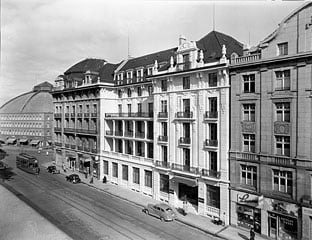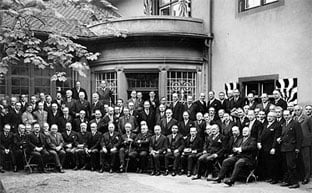EXTRACT -
In an April 7 [2009] article in The London Telegraph titled “The G20 Moves the World a Step Closer to
a Global Currency,” Ambrose Evans-Pritchard wrote:
“A single clause in Point 19 of the communiqué issued by the G20 leaders amounts to revolution in the global financial order.
“‘We have agreed to support a general SDR allocation which will inject $250bn (£170bn) into the world economy and increase global liquidity,’ it said. SDRs are Special Drawing Rights, a synthetic paper currency issued by the International Monetary Fund that has lain dormant for half a century.
“In effect, the G20 leaders have activated the IMF’s power to create money and begin global ‘quantitative easing’. In doing so, they are putting a de facto world currency into play. It is outside the control of any sovereign body. Conspiracy theorists will love it.”
Indeed they will. The article is subtitled, “The world is a step closer to a global currency, backed by a global central bank, running monetary policy for all humanity.” Which naturally raises the question, who or what will serve as this global central bank, cloaked with the power to issue the global currency and police monetary policy for all humanity? When the world’s central bankers met in Washington last September, they discussed what body might be in a position to serve in that awesome and fearful role. A former governor of the Bank of England stated:
“[T]he answer might already be staring us in the face, in the form of the Bank for International Settlements (BIS). . . . The IMF tends to couch its warnings about economic problems in very diplomatic language, but the BIS is more independent and much better placed to deal with this if it is given the power to do so.”1
And if the vision of a global currency outside government control does not set off conspiracy theorists, putting the BIS in charge of it surely will. The BIS has been scandal-ridden ever since it was branded with pro-Nazi leanings in the 1930s. Founded in Basel, Switzerland, in 1930, the BIS has been called “the most exclusive, secretive, and powerful supranational club in the world.” Charles Higham wrote in his book Trading with the Enemy that by the late 1930s, the BIS had assumed an openly pro-Nazi bias, a theme that was expanded on in a BBC Timewatch film titled “Banking with Hitler” broadcast in 1998.2 In 1944, the American government backed a resolution at the Bretton-Woods Conference calling for the liquidation of the BIS, following Czech accusations that it was laundering gold stolen by the Nazis from occupied Europe; but the central bankers succeeded in quietly snuffing out the American resolution.3

Modest beginnings, BIS Office, Hotel Savoy-Univers, Basel

First Annual General Meeting, 1931
In Tragedy and Hope: A History of the World in Our Time (1966), Dr. Carroll Quigley revealed the key role played in global finance by the BIS behind the scenes. Dr. Quigley was Professor of History at Georgetown University, where he was President Bill Clinton’s mentor. He was also an insider, groomed by the powerful clique he called “the international bankers.” His credibility is heightened by the fact that he actually espoused their goals. He wrote:
“I know of the operations of this network because I have studied it for twenty years and was permitted for two years, in the early 1960′s, to examine its papers and secret records. I have no aversion to it or to most of its aims and have, for much of my life, been close to it and to many of its instruments. . . . [I]n general my chief difference of opinion is that it wishes to remain unknown, and I believe its role in history is significant enough to be known.”
Quigley wrote of this international banking network:
“[T]he powers of financial capitalism had another far-reaching aim, nothing less than to create a world system of financial control in private hands able to dominate the political system of each country and the economy of the world as a whole. This system was to be controlled in a feudalist fashion by the central banks of the world acting in concert, by secret agreements arrived at in frequent private meetings and conferences. The apex of the system was to be the Bank for International Settlements in Basel, Switzerland, a private bank owned and controlled by the world’s central banks which were themselves private corporations.”
The key to their success, said Quigley, was that the international bankers would control and manipulate the money system of a nation while letting it appear to be controlled by the government. The statement echoed one made in the eighteenth century by the patriarch of what would become the most powerful banking dynasty in the world. Mayer Amschel Bauer Rothschild famously said in 1791:
“Allow me to issue and control a nation’s currency, and I care not who makes its laws.”
Mayer’s five sons were sent to the major capitals of Europe – London, Paris, Vienna, Berlin and Naples – with the mission of establishing a banking system that would be outside government control. The economic and political systems of nations would be controlled not by citizens but by bankers, for the benefit of bankers. Eventually, a privately-owned “central bank” was established in nearly every country; and this central banking system has now gained control over the economies of the world. Central banks have the authority to print money in their respective countries, and it is from these banks that governments must borrow money to pay their debts and fund their operations. The result is a global economy in which not only industry but government itself runs on “credit” (or debt) created by a banking monopoly headed by a network of private central banks; and at the top of this network is the BIS, the “central bank of central banks” in Basel.
Behind the Curtain
For many years the BIS kept a very low profile, operating behind the scenes in an abandoned hotel. It was here that decisions were reached to devalue or defend currencies, fix the price of gold, regulate offshore banking, and raise or lower short-term interest rates. In 1977, however, the BIS gave up its anonymity in exchange for more efficient headquarters. The new building has been described as “an eighteen story-high circular skyscraper that rises above the medieval city like some misplaced nuclear reactor.” It quickly became known as the “Tower of Basel.” Today the BIS has governmental immunity, pays no taxes, and has its own private police force.4 It is, as Mayer Rothschild envisioned, above the law.
The BIS is now composed of 55 member nations, but the club that meets regularly in Basel is a much smaller group; and even within it, there is a hierarchy. In a 1983 article in Harper’s Magazine called “Ruling the World of Money,” Edward Jay Epstein wrote that where the real business gets done is in “a sort of inner club made up of the half dozen or so powerful central bankers who find themselves more or less in the same monetary boat” – those from Germany, the United States, Switzerland, Italy, Japan and England. Epstein said:
“The prime value, which also seems to demarcate the inner club from the rest of the BIS members, is the firm belief that central banks should act independently of their home governments. . . . A second and closely related belief of the inner club is that politicians should not be trusted to decide the fate of the international monetary system.”
In 1974, the Basel Committee on Banking Supervision was created by the central bank Governors of the Group of Ten nations (now expanded to twenty). The BIS provides the twelve-member Secretariat for the Committee. The Committee, in turn, sets the rules for banking globally, including capital requirements and reserve controls. In a 2003 article titled “The Bank for International Settlements Calls for Global Currency,” Joan Veon wrote:
“The BIS is where all of the world’s central banks meet to analyze the global economy and determine what course of action they will take next to put more money in their pockets, since they control the amount of money in circulation and how much interest they are going to charge governments and banks for borrowing from them. . . .“When you understand that the BIS pulls the strings of the world’s monetary system, you then understand that they have the ability to create a financial boom or bust in a country. If that country is not doing what the money lenders want, then all they have to do is sell its currency.”5
The Controversial Basel Accords
The power of the BIS to make or break economies was demonstrated in 1988, when it issued a Basel Accord raising bank capital requirements from 6% to 8%. By then, Japan had emerged as the world’s largest creditor; but Japan’s banks were less well capitalized than other major international banks. Raising the capital requirement forced them to cut back on lending, creating a recession in Japan like that suffered in the U.S. today. Property prices fell and loans went into default as the security for them shriveled up. A downward spiral followed, ending with the total bankruptcy of the banks. The banks had to be nationalized, although that word was not used in order to avoid criticism. CONTD. Click link at top.

No comments:
Post a Comment